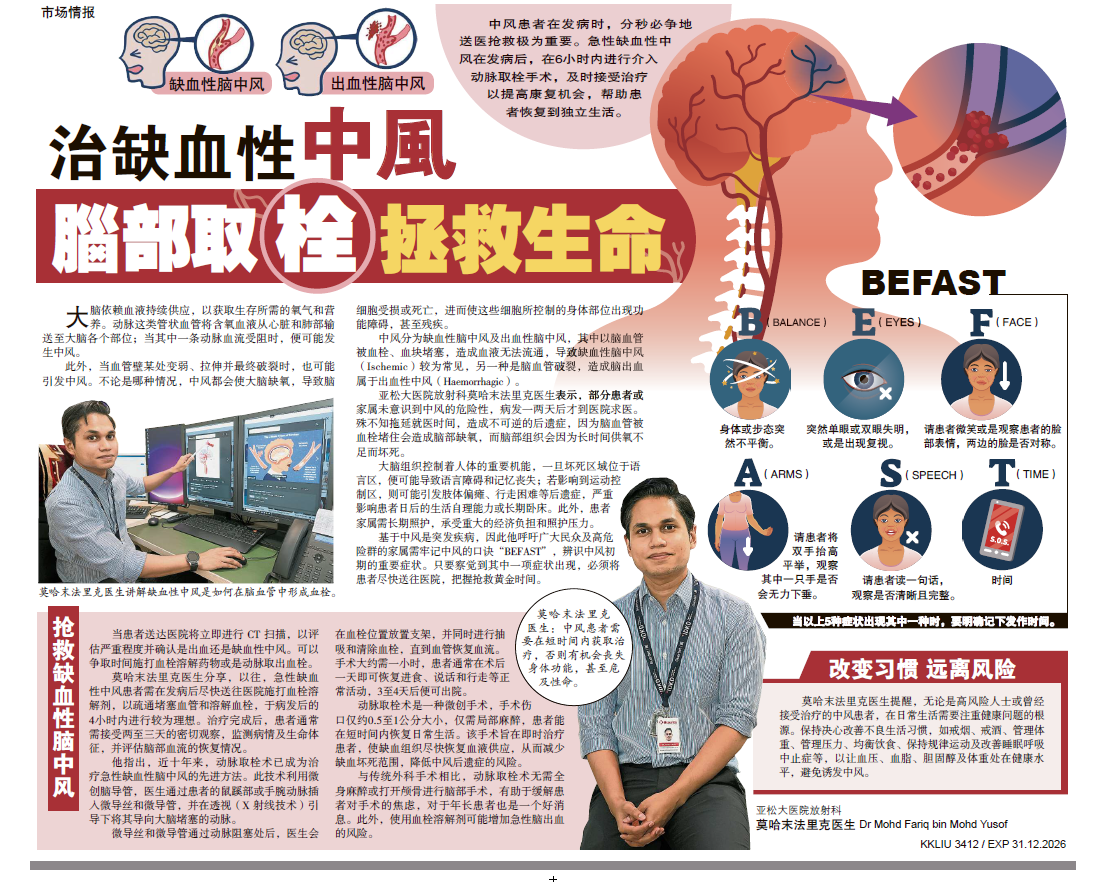Some people mistakenly think that a fever is just a common cold and believe that resting and taking antipyretic drugs can lead to a quick recovery, unaware that they may have contracted dengue fever. It is not until the symptoms worsen that they realize the seriousness of the problem and seek medical attention, leading to a late diagnosis and missing the optimal treatment window.
Dr. Ganasan Chelladurai, Head of the Emergency Department and Emergency Physician at Assunta Hospital, pointed out that the number of dengue fever cases in our country is on an upward trend, increasing every month from 2020 to 2024, with Selangor being the state with the highest number of confirmed cases nationwide.
Dengue fever is a viral infectious disease caused by the dengue virus, generally lasting two to three days of continuous fever or intermittent fever that comes and goes, accompanied by diarrhea, vomiting, nosebleeds, or gum bleeding. If fever persists for more than 3 days, one should seek medical attention as soon as possible. If treatment is delayed until after the 5th day, severe dengue fever is the worst-case scenario, where the patient may experience internal bleeding and organ dysfunction in the kidneys, brain, and liver, which can even be life-threatening.
Dr. Ganasan Chelladurai advises patients to visit the hospital’s emergency department for testing to obtain test results quickly. In comparison, smaller clinics need to send test samples to third-party laboratories, which will require more time to wait for test results, potentially delaying treatment.
The hospital’s emergency department has a triage system that determines the priority of treatment and handling based on the severity of the patient’s clinical presentation to ensure efficient processing. The triage system’s medical staff will perform a preliminary diagnosis for the patient, including measuring blood pressure, temperature, blood tests, and observing vital signs. Sometimes, a patient’s mental state may appear normal, but these comprehensive checks help medical staff assess the condition and assign the patient to the critical or semi-critical area.
Fever is the most common symptom of dengue fever, but it can also be caused by influenza, COVID-19, or other infections. Therefore, preliminary diagnosis helps identify whether the patient has contracted dengue fever. Currently, there are two rapid testing methods in our country: the dengue NS-1 antigen test and the dengue IgM antibody test.
In the early stages of dengue virus infection, during the fever period, the dengue NS-1 antigen test can diagnose the infection early, but its sensitivity is not 100%. The dengue IgM antibody test has higher sensitivity, but it cannot confirm the infection in the early stages of the patient’s fever because it requires waiting for the patient’s antibodies to reach a certain level before showing a positive reaction, which generally takes until the patient enters the recovery stage.
3 Stages of Dengue Fever
Generally, patients infected with dengue fever will go through three stages, with the second stage being the most critical.
Stage 1
Continuous fever for 3 to 5 days without subsiding, feeling muscle aches, back, abdominal and eye pain, and vomiting. Due to symptoms similar to COVID-19 and bacterial infections, doctors need to observe the patient’s white blood cell and platelet counts through blood tests to further diagnose and identify dengue fever.
Stage 2
Patients in this stage have a fever that subsides, but symptoms may persist. Some patients feel extremely fatigued, confused, have abdominal pain, vomiting, and diarrhea. Some may experience gum bleeding or nosebleeds.
Stage 3
The patient’s physical condition gradually stabilizes and recovers through their immune system. Patients need to rest in bed and drink plenty of water.
Doctors decide whether to admit patients based on the severity of their condition. If the situation is not serious, doctors usually advise patients to rest at home for the time being.
If the patient’s platelet count is not too low and there are no signs of shock, bleeding, or dehydration, they can recover at home. Patients need to return to the clinic daily for blood tests and drink 2 to 3 liters of water per day. If they cannot drink enough water, they need intravenous fluids until their platelets and other blood indicators return to normal.
For high-risk/semi-critical severe patients, the emergency department doctor will perform immediate ultrasound testing of the internal organs, blood tests, and manage symptoms through intravenous fluids to prevent the condition from worsening. Patients in the critical area with severe and persistent metabolic acidosis may experience hypotensive shock and liver or kidney failure.
Due to the patient’s fever and vomiting symptoms, the body loses a significant amount of water. Therefore, patients need to replenish water promptly, and it is recommended to drink plenty of plain water and soups. Soups contain a small amount of salt, which helps retain water when it enters the body. However, sugary drinks like fruit juices and coconut water promote urination and are not conducive to maintaining body fluids.
He added that the folk remedy of papaya leaf juice lacks sufficient scientific evidence and tastes bitter. Currently, the most important thing is to maintain adequate body fluids, and it is recommended that patients drink more palatable beverages like plain water and soups.
Prevention of Dengue Fever is Everyone’s Responsibility
The transmission vector of the “dengue virus” is mosquitoes carrying the virus. Dengue fever is a viral infection caused by the “dengue virus” (Dengue Viruses), with 4 serotypes, but it cannot be transmitted directly between people. Infection caused by one serotype can only provide protection against that serotype, and it is still possible to contract dengue fever again from other dengue virus serotypes. In other words, patients may be infected again, and symptoms may be more severe in secondary infections.
The public needs to raise awareness and ensure that the surrounding environment has no potential breeding grounds for Aedes mosquitoes, regularly conducting collective large-scale cleaning to inspect and eliminate Aedes breeding sites, including back alleys and community gardens, to prevent the spread of the virus.
Through these measures, we can work together to reduce the transmission of dengue fever and protect the health of ourselves and the community.
—
Dr. Ganasan Chelladurai, Head of the Emergency Department and Emergency Physician at Assunta Hospital
“If you suspect you have dengue fever or have been continuously running a fever, you should seek medical attention at the hospital as soon as possible.”
报道:杜安琪
摄影:辛柄耀
你以为蚊子叮咬是小事?
别忽视骨痛热症
引言:
部分人士误以为发烧只是普通感冒,认为多休息和退烧药就能快速康复,殊不知可能患上了骨痛热症。直到症状加重才意识到问题的严重性,这时才去求医,导致发现太迟并耽误了治疗时机。
内容:
阿松大医院急诊科主管兼急诊科医生加纳桑切拉杜莱指出,我国的骨痛热症病例数目呈增长趋势。
骨痛热症是一种由登革热病毒引起的病毒性传染病,一般持续发烧两至三天不退烧,或是反反复覆退烧了又重新发烧,并出现腹泻、呕吐、流鼻血或牙龈出血。一旦发烧3天以上应尽快就医,若是迟至5天后才求医,严重骨痛热症是最坏的情况,患者会内脏出血,器官如肾脏、大脑和肝脏等功能受损,甚至危及生命。
加纳桑切拉杜莱医生建议,患者前往医院急诊科室进行检测,以便在短时间内获得检测报告。相比之下,小型诊所需要将检测样本送往第三方实验室,这将需要更多时间来等待检测报告,可能会延误治疗时机。
医院急诊科设有分诊系统(Triage System),根据患者临床表现的严重程度决定治疗和处理优先级,确保患者能得到高效的处理。分诊系统的医护人员会为患者进行初步诊断,包括测量血压、体温、血液检验和观察症状等生命体征。有时,患者的精神状态看起来与正常人无异,但这些全面性的检查有助于医护人员判断病情,并将患者分配到危急(Critical)或高风险/半危急(Semi Critical)区域。
发烧是骨痛热症最常见的症状,但也可能由流感、冠病或其他感染引起,因此初步诊断有助于识别是否患上骨痛热症。目前我国有两种快速检测方法:骨痛热NS-1病原体检测(Dengue NS-1 Antigen Test)和骨痛热IgM抗体检测(Dengue IgM Antibody Test)。
在感染骨痛热病毒初期,也就是发热期,骨痛热NS-1病原体检测能及早诊断感染,但是此检测的敏感度并不是百分之百;骨痛热IgM抗体检测虽然敏感度较高,但无法在患者发热初期确定感染,因为需要等待患者体内的抗体达到一定水平后才呈阳性反应,一般这要等到患者进入恢复期才较明确。
小题:骨痛热症三阶段(做表格)
一般上,感染骨痛热症的患者会经历三个阶段,其中第二阶段是最关键的。
第一阶段:
- 持续发烧3至5天未退烧,感到肌肉酸痛、背部、腹部及眼睛疼痛及呕吐等。
- 由于症状与冠病、细菌感染的症状相似,医生需要透过验血观察白血球和血小板是否有下降趋势,进一步诊断和识别骨痛热症。
第二阶段:
- 患者在这个阶段退烧了,不过需注意症状是否依旧,部分患者感到疲累不已、困惑、腹部疼痛、呕吐和腹泻等,有者会出现牙龈出血或流鼻血。
第三阶段:
- 患者的身体状况逐渐恢复稳定,靠免疫力康复。
患者要卧床休息和多喝水
医生视患者的严重程度来决定是否让患者入院就医,如果情况不严重,医生通常会吁请病患暂时在家休养。
若患者的血小板指数不太低,且没有出现休克、出血等情况,体内水分也充足,可以留在家休养。患者需要每天回诊所抽血检验,并且每天饮用2至3公升的水。如果无法饮用足够的水,则需要通过吊点滴来补充,直到血小板和其它血液指标恢复正常。
进入高风险/半危急的重度患者,急诊科医生将为患者进行超音波即时检测内脏、抽血检验,通过静脉输液管理症状,避免病情恶化。危急区的重度患者可能出现低血压性休克,同时有肝、肾衰竭或严重及持续性的代谢性血酸症。
由于患者出现高烧和呕吐的症状,导致身体失去大量水分。因此,患者需要及时补充足够的水分,建议多喝白开水、汤类等。汤类含有少量盐分,盐分进入体内后有助于保留水分。然而,果汁和椰子水等含糖饮料会促进排尿,不利于保持体内水分。
他补充,民间流传的木瓜叶汁偏方没有足够科学证据,且味道苦涩。当前最重要的是保持体内水分充足,建议患者多喝更容易下咽的饮料,如白开水和汤类。
预防骨痛热症人人有责
“登革热病毒”的传播媒介是带有病毒的蚊子。骨痛热症属于病毒感染,病原乃“登革热病毒”(Dengue Viruses),共有4种血清型,但不会通过人与人之间进行直接传播。一种血清型导致的感染只能对该血清型产生保护作用,由其它登革病毒血清型感染而再次罹患骨痛热症还是有可能发生的。换言之,患者可能再次受感染,并且二度感染时,症状可能会更加严重。
公众需提高防范意识,确保周遭环境没有黑斑蚊的潜在地点,并定期集体大扫除检查及消灭黑斑纹温床,包括后巷及社区花园,以防病毒扩散。
通过以上措施,我们可以共同努力减少骨痛热症的传播,保护自己和社区的健康。
圖:阿松大医院急诊科主管兼急诊科医生加纳桑切拉杜莱
Dr Ganasan Chelladurai
加纳桑切拉杜莱医生:当你怀疑患上骨痛热症或一直发烧,应尽快前往医院求医。

Related Articles











